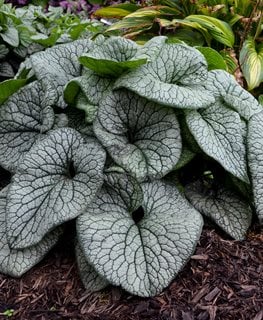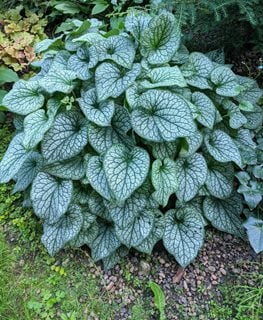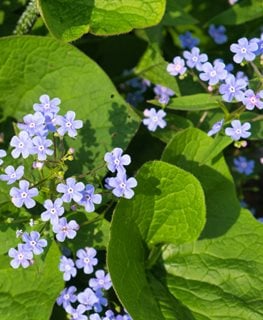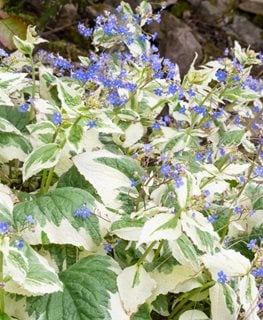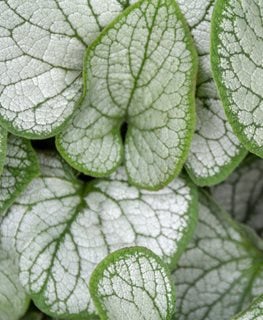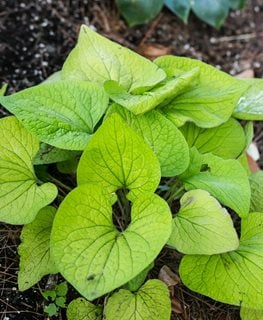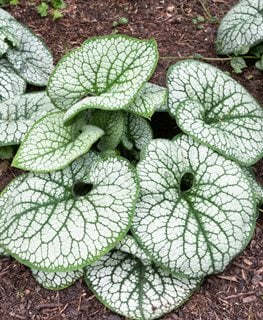HOW TO GROW & CARE FOR BRUNNERA IN YOUR GARDEN
Brighten up shady areas with this stunning bold-leafed perennial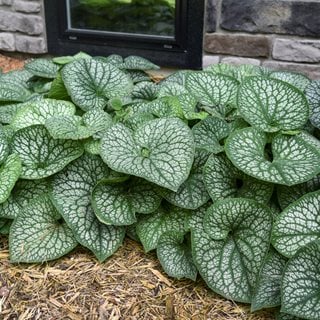
'Jack of Diamonds' brunnera. Photo: Proven Winners
With large heart-shaped leaves and delicate sprays of sky blue flowers, Brunnera adds dramatic long-lasting color to shady beds and borders. Newer cultivars produce eye-catching foliage with intricate silver or white patterns.
Also known as Siberian bugloss, heartleaf brunnera, and false forget-me-not, this borage relative is native to the Caucasus region. This exceptionally hardy perennial, which spreads through rhizomatous roots, is tolerant of a wide range of growing conditions, thriving in shady areas where other plants struggle to survive.
Brunnera needs little care once established and is virtually free of pests and diseases. Use this versatile plant as a ground cover, in shady woodland borders, containers, or mass plantings. Here’s how to grow and use it in your landscape.
2025 Perennial of the Year:
'Jack of Diamonds' Heartleaf Brunnera.
On this page: Basics | Planting | Care | Pictures | Frequently Asked Questions | Landscaping Ideas
On this page:
- BASICS
- HOW TO PLANT BRUNNERA
- BRUNNERA CARE
- BRUNNERA VARIETIES
- FREQUENTLY ASKED QUESTIONS
- DESIGN IDEAS
BRUNNERA BASICS
Botanical name:
Brunnera macrophylla
Plant type:
Herbaceous perennial; plants spread through creeping rhizomes and seeding
Zones:
3-9; plants do best in cooler climates
Exposure:
Partial shade to full shade
Habit:
Clumping or spreading habit with a slow growth rate
Height/Spread:
8 to 18 inches tall, 18 to 30 inches wide
Bloom time:
Mid to late spring
Flowers:
Airy clusters of tiny vivid blue flowers are reminiscent of forget-me-nots. The showy flowers bloom for up to 10 weeks in mid to late spring.
Foliage:
Large heart-shaped leaves 3 to 6 inches long or more are green, gold, or variegated in colors of silver or white. The thick, fuzzy-textured leaves reach their full size once the flowers have faded. Foliage dies back in winter in colder regions, but will remain evergreen in warmer climates.
Toxicity:
Brunnera plants are not toxic to humans or animals.
HOW TO PLANT BRUNNERA
When to plant:
Plant brunnera during milder months in spring or fall to avoid stress from extreme heat or cold.
Where to plant:
Choose a site with part shade to full shade and protection from hot afternoon sun. Too much direct sun can cause leaf scorch.
How to plant:
Loosen soil in the planting area and amend with compost or other rich organic matter. Dig a hole twice as wide and the same depth as the root ball. Remove plant from the nursery container and tease out roots if potbound. Place in the hole so the top of the root ball is level with the surrounding soil. Fill in the hole with soil, tamp down gently, and water thoroughly. Water regularly until plants are established. Space plants 18 to 30 inches apart, depending on the variety.
BRUNNERA CARE
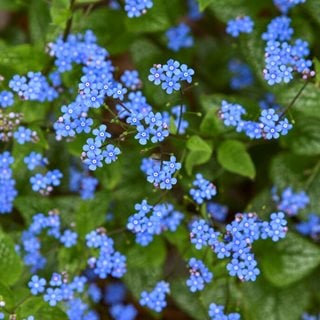
'Jack of Diamonds' brunnera flowers. Photo: Proven Winners
Soil:
Brunnera prefers fertile, well-drained soil and a pH of 6.0-8.0. Amend native soil with compost or other rich organic matter before planting. Mulch with a thin layer of compost in spring to add nutrients, suppress weeds, and keep the root zone cool.
Amendments & fertilizer:
Plants need little or no supplemental fertilizer. If desired, apply a slow release all-purpose fertilizer in spring or spread a thin layer of compost around the base of plants.
Watering:
Brunnera prefers moist soil and regular water. Don’t allow soil to dry out completely, and avoid overwatering to prevent root rot.
Pruning:
Foliage can become dried and brown from too much sun or drought. Remove damaged leaves as they occur. Foliage will rejuvenate if cut back. Cut off spent flowers to keep a neat appearance. Remove dead leaves in early spring before new growth emerges. Variegated cultivars occasionally produce green leaves, which should be removed as soon as they appear to prevent reversion.
Pests and diseases:
Brunnera is free of most pests and diseases. Pests can include nematodes, slugs or snails. Diseases include root rot from overwatering.
BRUNNERA VARIETIES
FREQUENTLY ASKED QUESTIONS
Does brunnera come back every year?
Brunnera is a hardy long-lived perennial that comes back reliably from year to year.
How big do brunnera plants get?
Plants reach 8 to 18 inches tall and 18 to 30 inches wide, depending on the variety.
Do deer eat brunnera plants?
Deer tend to avoid brunnera due to the rough texture of the leaves, though grazing can occur if other food sources are scarce.
Is brunnera cold hardy?
Most brunnera varieties are extremely hardy, to USDA zones 3-4.
BRUNNERA LANDSCAPING TIPS
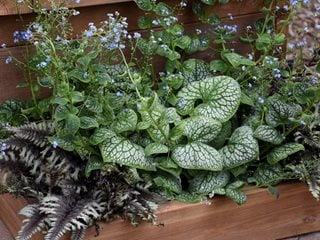
'Jack of Diamonds' brunnera in a mixed shade container. Photo: Proven Winners
For borders and landscapes:
Use brunnera at the front of mixed borders, in mass plantings or as edging.
For slopes and hillsides:
Mass brunnera along a shady slope to help stem erosion.
For containers:
Place in a container by itself or alongside other shade-loving plants.
There are many ways to use brunnera in your landscape. Here’s how:
- Use this woodland plant in combination with other shade-loving trees, shrubs, and perennials for a layered tapestry.
- Naturalize moisture-loving brunnera plants along a stream or pond.
- Mass brunnera plants underneath trees or shrubs for an attractive season-long ground cover.
- Plant a variegated or gold-foliaged variety in a decorative container and use to brighten up a shady spot.
- Use brunnera as pathway edging in a shady side or back yard.
- Mass as a ground cover along a shady slope.
- Place at the front of a mixed border in groupings of 3 to 5 for the most impact.
- Use a variegated or gold-leafed variety as a focal point to draw the eye through a shady bed.
Companion plants: Brunnera combines well with many other shade lovers including astilbe, bergenia, bishop’s hat, bleeding heart, coral bells, ferns, foamflower, geranium, hellebore, hosta, hydrangea, iris, Jacob’s ladder, lamium, lungwort and Solomon’s seal.
RELATED:
21 Great Plants for Shade
Design with Foliage Over Flowers
8 Tips for Stunning Shade Combinations
